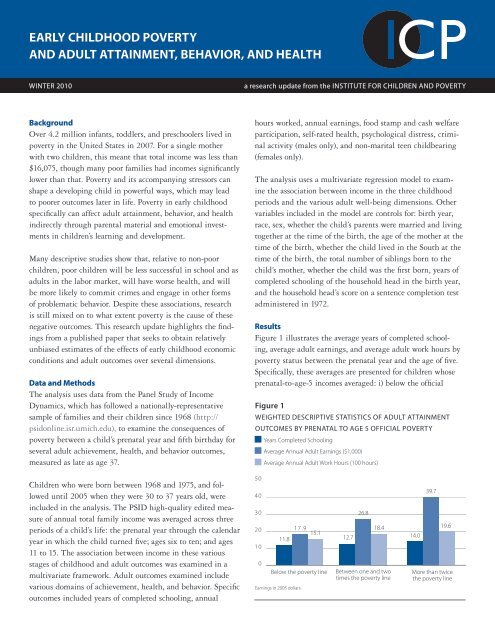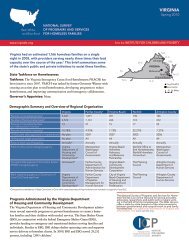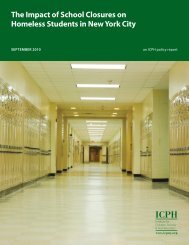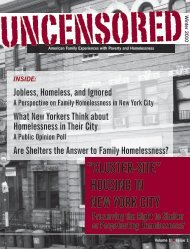early childhood poverty and adult attainment, behavior, and health
early childhood poverty and adult attainment, behavior, and health
early childhood poverty and adult attainment, behavior, and health
You also want an ePaper? Increase the reach of your titles
YUMPU automatically turns print PDFs into web optimized ePapers that Google loves.
EARLY CHILDHOOD POVERTY<br />
AND ADULT ATTAINMENT, BEHAVIOR, AND HEALTH<br />
WINTER 2010<br />
A R Ea Presearch O R T F R Oupdate M T H E from I N Sthe T I TINSTITUTE U T E F O R FOR C H ICHILDREN L D R E N A NAND D PPOVERTY<br />
O V E R T Background<br />
Over 4.2 million infants, toddlers, <strong>and</strong> preschoolers lived in<br />
<strong>poverty</strong> in the United States in 2007. For a single mother<br />
with two children, this meant that total income was less than<br />
$16,075, though many poor families had incomes significantly<br />
lower than that. Poverty <strong>and</strong> its accompanying stressors can<br />
shape a developing child in powerful ways, which may lead<br />
to poorer outcomes later in life. Poverty in <strong>early</strong> <strong>childhood</strong><br />
specifically can affect <strong>adult</strong> <strong>attainment</strong>, <strong>behavior</strong>, <strong>and</strong> <strong>health</strong><br />
indirectly through parental material <strong>and</strong> emotional investments<br />
in children’s learning <strong>and</strong> development.<br />
Many descriptive studies show that, relative to non-poor<br />
children, poor children will be less successful in school <strong>and</strong> as<br />
<strong>adult</strong>s in the labor market, will have worse <strong>health</strong>, <strong>and</strong> will<br />
be more likely to commit crimes <strong>and</strong> engage in other forms<br />
of problematic <strong>behavior</strong>. Despite these associations, research<br />
is still mixed on to what extent <strong>poverty</strong> is the cause of these<br />
negative outcomes. This research update highlights the findings<br />
from a published paper that seeks to obtain relatively<br />
unbiased estimates of the effects of <strong>early</strong> <strong>childhood</strong> economic<br />
conditions <strong>and</strong> <strong>adult</strong> outcomes over several dimensions.<br />
Data <strong>and</strong> Methods<br />
The analysis uses data from the Panel Study of Income<br />
Dynamics, which has followed a nationally-representative<br />
sample of families <strong>and</strong> their children since 1968 (http://<br />
psidonline.isr.umich.edu), to examine the consequences of<br />
<strong>poverty</strong> between a child’s prenatal year <strong>and</strong> fifth birthday for<br />
several <strong>adult</strong> achievement, <strong>health</strong>, <strong>and</strong> <strong>behavior</strong> outcomes,<br />
measured as late as age 37.<br />
Children who were born between 1968 <strong>and</strong> 1975, <strong>and</strong> followed<br />
until 2005 when they were 30 to 37 years old, were<br />
included in the analysis. The PSID high-quality edited measure<br />
of annual total family income was averaged across three<br />
periods of a child’s life: the prenatal year through the calendar<br />
year in which the child turned five; ages six to ten; <strong>and</strong> ages<br />
11 to 15. The association between income in these various<br />
stages of <strong>childhood</strong> <strong>and</strong> <strong>adult</strong> outcomes was examined in a<br />
multivariate framework. Adult outcomes examined include<br />
various domains of achievement, <strong>health</strong>, <strong>and</strong> <strong>behavior</strong>. Specific<br />
outcomes included years of completed schooling, annual<br />
hours worked, annual earnings, food stamp <strong>and</strong> cash welfare<br />
participation, self-rated <strong>health</strong>, psychological distress, criminal<br />
activity (males only), <strong>and</strong> non-marital teen childbearing<br />
(females only).<br />
The analysis uses a multivariate regression model to examine<br />
the association between income in the three <strong>childhood</strong><br />
periods <strong>and</strong> the various <strong>adult</strong> well-being dimensions. Other<br />
variables included in the model are controls for: birth year,<br />
race, sex, whether the child’s parents were married <strong>and</strong> living<br />
together at the time of the birth, the age of the mother at the<br />
time of the birth, whether the child lived in the South at the<br />
time of the birth, the total number of siblings born to the<br />
child’s mother, whether the child was the first born, years of<br />
completed schooling of the household head in the birth year,<br />
<strong>and</strong> the household head’s score on a sentence completion test<br />
administered in 1972.<br />
Results<br />
Figure 1 illustrates the average years of completed schooling,<br />
average <strong>adult</strong> earnings, <strong>and</strong> average <strong>adult</strong> work hours by<br />
<strong>poverty</strong> status between the prenatal year <strong>and</strong> the age of five.<br />
Specifically, these averages are presented for children whose<br />
prenatal-to-age-5 incomes averaged: i) below the official<br />
Figure 1<br />
WEIGHTED DESCRIPTIVE STATISTICS OF ADULT ATTAINMENT<br />
OUTCOMES BY PRENATAL TO AGE 5 OFFICIAL POVERTY<br />
50<br />
40<br />
30<br />
20<br />
10<br />
0<br />
Years Completed Schooling<br />
Average Annual Adult Earnings ($1,000)<br />
Average Annual Adult Work Hours (100 hours)<br />
11.8<br />
17.9 18.4<br />
15.1<br />
12.7 14.0<br />
Below the <strong>poverty</strong> line<br />
Earnings in 2005 dollars.<br />
26.8<br />
Between one <strong>and</strong> two<br />
times the <strong>poverty</strong> line<br />
39.7<br />
19.6<br />
More than twice<br />
the <strong>poverty</strong> line
page 2<br />
Early Childhood Poverty <strong>and</strong> Adult Attainment, Behavior, <strong>and</strong> Health<br />
<strong>poverty</strong> line (200%). This figure shows striking differences in <strong>adult</strong><br />
outcomes depending on where <strong>childhood</strong> income prior to age<br />
six was with respect to the <strong>poverty</strong> line. Compared with children<br />
whose families had incomes of at least twice the <strong>poverty</strong><br />
line during their <strong>early</strong> <strong>childhood</strong> (group iii), poor children<br />
(group i) complete two fewer years of schooling, earn less than<br />
half as much <strong>and</strong> work 451 fewer hours per year.<br />
30 years later. This analysis indicates that policy makers<br />
might do well to focus interventions involving deep <strong>and</strong> persistent<br />
<strong>poverty</strong> <strong>early</strong> in <strong>childhood</strong>.<br />
This research update was adapted from “Early Childhood<br />
Poverty <strong>and</strong> Adult Attainment, Behavior, <strong>and</strong> Health” by<br />
Greg J. Duncan, Kathleen M. Ziol-Guest, <strong>and</strong> Ariel Kalil<br />
(in Child Development, January/February 2010, Volume 81,<br />
No. 1, pp. 292–311).<br />
Multivariate results show that the timing of economic deprivation<br />
during <strong>childhood</strong> indeed matters. Holding constant<br />
parental education, family structure <strong>and</strong> a host of other<br />
demographic conditions at birth, additional income for poor<br />
children during the prenatal to age five period is associated<br />
with significantly higher <strong>adult</strong> earnings <strong>and</strong> work hours. On<br />
the contrary, additional income for non-poor children does<br />
not show this association. For example, an additional $10,000<br />
each year between prenatal <strong>and</strong> their fifth birthday for poor<br />
children increases their average annual <strong>adult</strong> earnings by<br />
68.2%, compared with only a 5.1% increase among the nonpoor<br />
for the same additional $10,000.<br />
Table 1<br />
OLS Spline Regression Coefficients for Early Childhood Income<br />
Additional $10,000 in annual<br />
income for a poor child<br />
between prenatal <strong>and</strong> age five<br />
Additional $10,000 in annual<br />
income for a non-poor child<br />
between prenatal <strong>and</strong> age five<br />
Years<br />
Completed<br />
Schooling<br />
Average<br />
Annual Adult<br />
Earnings<br />
Average<br />
Annual Adult<br />
Work Hours<br />
.19 68.2% * 507**<br />
.03 5.1% 21*<br />
*p < .05; **p < .01 Income <strong>and</strong> earnings in 2005 dollars.<br />
Conclusions <strong>and</strong> Policy Implications<br />
This is the first study to link high-quality income data across<br />
the entire <strong>childhood</strong> period with outcomes in middle <strong>adult</strong>hood.<br />
It finds that economic conditions in <strong>early</strong> <strong>childhood</strong><br />
matter more than economic conditions in later periods for<br />
labor market success, a result that corroborates the growing<br />
body of intervention evidence linking enriched <strong>early</strong><br />
<strong>childhood</strong> environments to long-run successes. The findings<br />
suggest that a $3,000 annual increase in income during <strong>early</strong><br />
<strong>childhood</strong> (well within the magnitude of past policy changes<br />
such as the federal Earned Income Tax Credit) translates into<br />
19% higher earnings in <strong>adult</strong>hood <strong>and</strong> a 135-hour annual<br />
increase in work hours. Reductions in <strong>childhood</strong> <strong>poverty</strong><br />
could have large impacts, not only when children are young,<br />
but could persist well into <strong>adult</strong>hood <strong>and</strong> have a positive<br />
influence on labor force participation <strong>and</strong> economic well-being<br />
The Institute for Children <strong>and</strong> Poverty (ICP) is an independent non-profit<br />
research organization based in New York City. ICP studies the impact of<br />
<strong>poverty</strong> on family <strong>and</strong> child well-being <strong>and</strong> generates research that will<br />
enhance public policies <strong>and</strong> programs affecting poor or homeless children<br />
<strong>and</strong> their families. Specifically, ICP examines the condition of extreme<br />
<strong>poverty</strong> in the United States <strong>and</strong> its effect on educational <strong>attainment</strong>, housing,<br />
employment, child welfare, domestic violence, <strong>and</strong> family wellness.<br />
Please visit our Web site for more information. www.icpny.org










